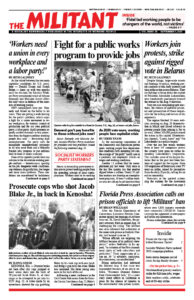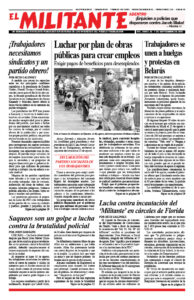BATH, Maine — Shipbuilders at Bath Iron Works voted by 87% to approve a three-year contract and returned to work Aug. 24 following a hard-fought 63-day strike after rejecting the bosses “last, best and final” anti-union contract offer. The workers are members of Machinists Local S6.
The voting was done online after a week of discussion at the union hall.
The shipyard builds destroyers for the Navy. It is one of the larger military contractors in the country, employing 6,800 workers, 4,300 of whom are in Local S6.
The bosses had counted on being able to play hundreds of newer hires against veteran union members. Their goal was to increase the number of nonunion contract workers in the shipyard and undermine the union’s control over seniority in filling jobs and making shift and overtime assignments.
Faced with a unified strike and government pressure to resume production, the bosses agreed to federal mediation, leading to new negotiations. Difficulties in hiring strikebreakers or getting workers to cross the picket line meant they couldn’t keep production running.
“We got what we wanted,” Local S6 member Laurie Dorr told the Militant at a union-organized pig roast Aug. 22. “Seniority and subcontractors were the main issues for us.” Over 100 workers, family members and strike supporters gathered at the union hall to celebrate what many here described as a victory.
“We won and this is what solidarity looks like,” Robert Martinez, president of the international union, said at the rally. He praised the unionists for standing strong in face of company pressure.
The three-year contract has a 3% annual wage increase with a signing bonus of $1,200, as well as protecting seniority and a limit on nonunion contractors.
There were some concessions. Health care costs will go up, but less than bosses wanted. The “last, best” company offer had a 5% annual increase, but the contract passed has a 4% increase in the first year and 3% in each of the next two.
While the agreement allows the company flexibility to catch up with production until the end of 2020, subcontractors will be phased out then.
As part of the arrangement to end the strike, union officials agreed to take down the pickets before the contract vote. This led to a lively debate at the union hall as strikers came in to discuss the agreement and qualify for strike pay.
‘Unity and solidarity key’
“Solidarity was key,” said Marc Bubar, a 34-year veteran at the shipyard. He described how the union organized to reach out and won support from unions, workers and local businesses in the area. “Many took signs and displayed them in their windows.”
“Community support and an unwavering organized membership were the decisive elements to the success of the strike,” shipbuilder Andy James said. He described his activity in the strike action committee, organizing a food pantry through the union hall and outreach to local businesses to find jobs strikers could take to help cover expenses and keep the strike solid.
“It was solidarity among union members which won the strike,” Laura Safford agreed. “Newer members like me learned we can fight, and we can win. We are a stronger union going back.”
“Some thought we should keep fighting around wages and benefits,” she said. “But we gained strength and can win those battles when the right time comes.”
“We stand taller going back into the shipyard,” said Tiffany Briggs, a newer worker at the shipyard. “A lot of people will have more confidence in the union.”

